Archive:Information society statistics
- Data from August 2012. Most recent data: Further Eurostat information, Main tables and Database.

(% of all households) - Source: Eurostat (isoc_pibi_hiac) and (isoc_pibi_hba)
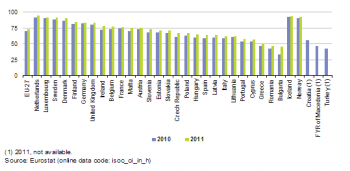
(% of all households) - Source: Eurostat (isoc_ci_in_h)
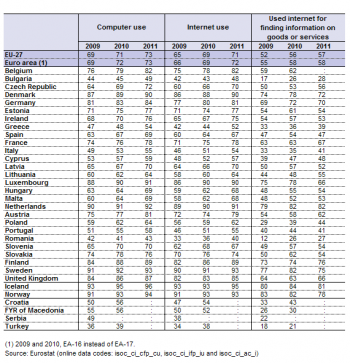
(% of individuals aged 16 to 74) - Source: Eurostat (isoc_ci_cfp_cu), (isoc_ci_ifp_iu) and (isoc_ci_ac_i)
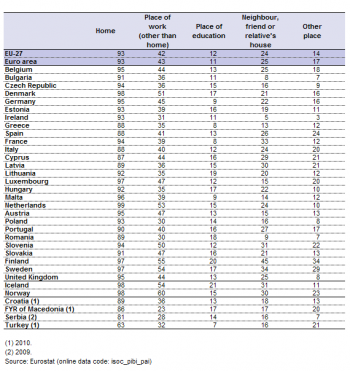
(% of internet users aged 16 to 74) - Source: Eurostat (isoc_pibi_pai)

(% of individuals aged 16 to 74) - Source: Eurostat (isoc_ci_ifp_iu) and (isoc_ci_ifp_fu)

(% of individuals aged 16 to 74) - Source: Eurostat (isoc_ec_ibuy)
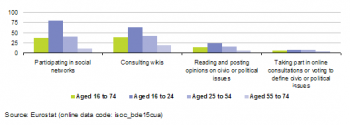
(% of individuals) - Source: Eurostat (isoc_bde15cua)

(% of enterprises) - Source: Eurostat (isoc_ci_in_en2), (isoc_ci_it_en2), (isoc_ci_cd_en2) and (isoc_bde15ee)
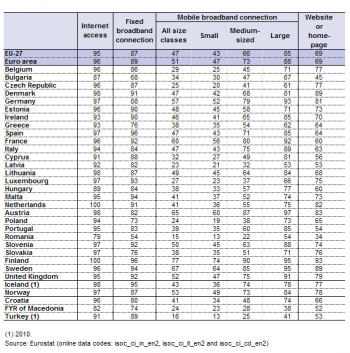
(% of enterprises) - Source: Eurostat (isoc_ci_in_en2), (isoc_ci_it_en2) and (isoc_ci_cd_en2)
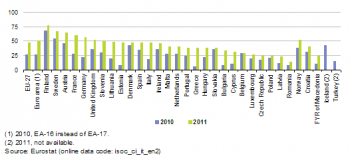
(% of enterprises) - Source: Eurostat (isoc_ci_it_en2)
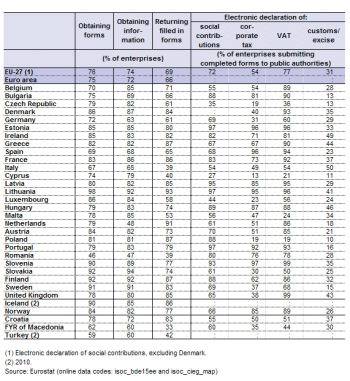

(% of enterprises using RFID) - Source: Eurostat (isoc_ci_cd_en2)
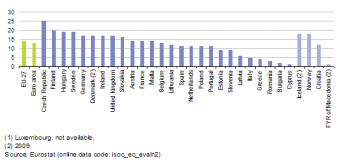
(% of total turnover) - Source: Eurostat (isoc_ec_evaln2)

(% of enterprises) - Source: Eurostat (isoc_ec_eseln2)

(% of enterprises) - Source: Eurostat (isoc_ec_eseln2), (isoc_ec_ebuyn2) and (isoc_ci_cd_en2)
This article presents recent statistical data on many different aspects of the information society in the European Union (EU). Progress in the development of the information society is regarded as critical to improve the competitiveness of EU industry and, more generally, to meet the demands of society and the EU economy.
Information and communication technologies (ICT) affect people's everyday lives in many ways, both at work and in the home, for example when communicating or buying online. EU policies range from regulating entire areas such as e-commerce to trying to protect an individual's privacy.
Main statistical findings
Households and individuals
During the last decade, ICT have become widely available to the general public, both in terms of accessibility as well as cost. A boundary was crossed in 2007, when a majority (55 %) of households in the EU-27 had internet access. This proportion continued to increase and in 2011 reached 73 %, rising by an additional 3 percentage points compared with 2010. Widespread and affordable broadband access is one of the means of promoting a knowledge-based and informed society. In all Member States broadband was by far the most common form of internet access, used by 67 % of all EU-27 households in 2011, more than double the share in 2006 - see Figure 1.
The highest proportion (94 %) of households with internet access in 2011 was recorded in the Netherlands (see Figure 2), while Luxembourg, Sweden and Denmark also reported that at least nine out of every ten households had internet access in 2011. The lowest rate of internet access among the Member States was recorded in Bulgaria (45 %). However, there was a rapid expansion in household access to the internet in Bulgaria, as the proportion of households with access rose by 12 percentage points between 2010 and 2011. Romania was the only other Member State where fewer than half of all households had internet access.
As of the beginning of 2011, just over seven out of every ten individuals in the EU-27, aged between 16 and 74 years, used a computer, while a similar proportion used the internet. At least nine out of every ten individuals in Sweden, the Netherlands, Luxembourg and Denmark used a computer and used the internet. However, less than half of all individuals aged 16 to 74 used a computer and the internet in Bulgaria and Romania. More than half (57 %) of the individuals in the EU-27 used the internet for finding information on goods or services in 2011 – see Table 1.
Among internet users, in other words, those individuals within the EU-27 using the internet in the three months before the ICT survey, more than nine out of every ten (93 %) accessed the internet from home in 2011, as shown in Table 2. In comparison, less than half of this subset of the population accessed the internet at work (42 %), which in turn was around double the proportion accessing the internet from a friend's, neighbour's or relative’s house (24 %). The large majority of internet users accessed the internet on a daily basis – see Figure 3.
The proportion of individuals who ordered goods or services over the internet for private use has risen. In 2011, 43 % of individuals aged 16 to 74 stated that they had ordered at least once over the internet – an increase of 3 percentage points compared with 2010 (see Figure 4). More than two thirds of individuals in the United Kingdom, Sweden, Denmark and the Netherlands ordered goods or services over the internet, whereas the proportion was no higher than one person in five in Latvia, Portugal, Greece, Lithuania and Italy; the lowest proportions of individuals ordering goods and services over the internet were registered in Bulgaria (7 %) and Romania (6 %).
Figure 5 presents information relating to the use of the internet by individuals for social networking and a range of other relatively new activities such as consulting wikis, reading and posting opinions on civic or political issues, and taking part in online consultations or voting. While an average of 38 % of individuals in the EU-27 aged 16 to 74 participated in social networks in 2011, there was a wide diversity in the use of these services when broken down by age group. The proportion of individuals aged 55 to 74 using social networks stood at 11 %, in sharp contrast to the 80 % recorded for those aged 16 to 24. This means that social networks play a vital role for maintaining social contacts among the younger age group. Overall, the youngest age group made greater use (than their elders) of all four activities presented in Figure 5.
In 2011, a majority of individuals in the EU-27 had some basic computer skills that allowed them to copy or move files or folders: this was the case for 63 % of persons aged 16 to 74 and 89 % of those aged 16 to 24. Less than half of the population (aged 16 to 74) used basic arithmetic formulae in spreadsheets (43 %), about one third created electronic presentations (31 %) and one in ten wrote computer programs (10 %). The proportion of persons aged 16 to 24 with these computer skills was much higher. Two thirds of the younger generation used formulae in spreadsheets, almost six out of ten created electronic presentations, and one in five wrote computer programs.
Enterprises
One in 20 enterprises in the EU-27 (covered by the survey on ICT usage in enterprises) did not have internet access as of the beginning of 2011 (see Figure 6), while the vast majority (87 %) made use of a fixed broadband connection to access the internet. There was a rapid uptake in the use of mobile broadband technologies – in part fuelled by enterprises equipping their staff with 3G USB sticks, smart phones and other mobile devices – as almost half (47 %) of enterprises in the EU-27 used mobile broadband at the start of 2011; this was 20 percentage points higher than the corresponding share for January 2010. Around seven out of every ten enterprises in the EU-27 had their own website. A similar proportion of enterprises used the internet to submit completed forms electronically to public authorities.
By the start of 2011, the proportion of enterprises with internet access exceeded 90 % in all Member States except Romania, Bulgaria and Hungary, while Romania and Bulgaria were the only Member States where less than half of the enterprise population had a website – see Table 4. At the start of 2011, more than three quarters of all enterprises in Finland used mobile broadband connections to access the internet – see Figure 7. This figure was considerably higher than in any other Member State, while Sweden, Austria, France, Germany and the United Kingdom were the only other countries to report that more than half of their enterprises made use of mobile broadband connections.
As of January 2011 around three quarters of all enterprises in the EU-27 made use of the internet in order to obtain forms or information from public authorities, while a slightly lower proportion (69 %) returned filled in forms to public authorities over the internet; for this latter group, the most common operations included making declarations for VAT and social contributions – see Table 5.
Radio-frequency identification (RFID) is a technology that may be used for the purpose of automatic identification and tracking; it may be used for a range of objects and in a variety of situations, although some common applications include: manufacturers using tags to track the location of each product they make; transport services enterprises using tags to track their vehicles; domestic use to be able to locate vulnerable people. Figure 8 provides some details relating to the proportion of enterprises using RFID in January 2011 and shows that the principal use made of RFID among EU-27 enterprises was for person identification and access control.
In total, e-commerce accounted for around 14 % of turnover among enterprises with at least ten persons employed in the EU-27, a share that ranged from 1 % in Cyprus to 25 % in the Czech Republic in 2010 (see Figure 9). Some 15 % of enterprises in the EU-27 sold goods or services online during 2010, which was less than half the proportion of enterprises (35 %) that made purchases online (see Figure 11). The percentage of enterprises selling online was highest in the accommodation sector (58 %), whereas the highest proportion of enterprises making online purchases was recorded for information and communication services (60 %).
Data sources and availability
Statisticians are well aware of the challenges posed by rapid technological change in areas related to the internet and other new applications of ICTs. As such, there has been a considerable degree of evolution in this area, with statistical tools being adapted to satisfy new demands for data. Indeed, statistics within this domain are reassessed on an annual basis in order to meet user needs and reflect the rapid pace of technological change.
This approach is replicated in Eurostat’s survey on ICT usage in households and by individuals and in its survey on ICT usage in enterprises. These annual surveys are used to benchmark ICT-driven developments, both by following developments for core variables over time and by looking in greater depth at other aspects at a specific point in time. While the surveys initially concentrated on access and connectivity issues, their scope has subsequently been extended to cover a variety of subjects (for example, e-government and e-commerce) and socio-economic analysis, such as regional diversity, gender specificity, age, educational differences and the individual’s employment situation in the household survey, or an analysis by enterprise size (small, medium-sized and large enterprises) in the enterprise survey. The scope of the surveys with respect to different technologies is also adapted so as to cover new product groups and means of delivering communication technologies to end-users (enterprises and households).
Households and individuals
The household survey covers those households having at least one member in the age group 16 to 74 years old. Internet access of households refers to the percentage of households that have an internet access, so that anyone in the household could use the internet at home, if so desired, even simply to send an e-mail. Internet users are defined as all individuals aged 16-74 who had used the internet in the three months prior to the survey. Regular internet users are individuals who used the internet, on average, at least once a week in the three months prior to the survey. The reference period for this survey was the first quarter of 2011; the survey period was the second quarter in most countries. A special module on ICT skills formed part of the 2011 survey.
The technologies most commonly used to access the internet are divided between broadband and dial-up access over a normal or an ISDN telephone line. Broadband includes digital subscriber lines (DSL) and uses technology that transports data at high speeds. Broadband lines are defined as having a capacity higher than ISDN, meaning equal to or higher than 144 kbit/s.
A computer is defined as a personal computer powered by one of the major operating systems (Macintosh, Linux or Microsoft); handheld computers or palmtops (PDAs) are also included.
The ordering of goods and services by individuals refers to the twelve months prior to the survey and includes confirmed reservations for accommodation, purchasing financial investments, participation in lotteries and betting, internet auctions, as well as information services from the internet that are directly paid for. Goods and services that are obtained via the internet for free are excluded. Orders made by manually typed e-mails are also excluded.
Enterprises
The survey on ICT usage in enterprises covers enterprises that have at least ten persons employed. The activity coverage is restricted to those enterprises whose principal activity is within manufacturing, electricity, gas, steam and water supply, sewerage and waste management, construction, wholesale and retail trade, repair of motor vehicles and motorcycles, transportation and storage, accommodation and food service activities, information and communication, real estate, professional, scientific and technical activities, administrative and support activities and the repair of computers and communication equipment (as defined by NACE Rev. 2 Sections C to N excluding Division 75 plus Group 95.1); the financial and insurance activities (Section K) are covered by the survey but are excluded from the analysis presented here.
The data collected through the enterprise survey can be analysed according to enterprise size (in terms of persons employed), with data presented for small (10-49 persons employed), medium-sized (50-249) and large (250 or more persons employed) enterprises.
ICT usage data are grouped according to the year in which the survey was conducted; most data refer to the situation in January of the reference/survey year. A special module on the use of public services formed part of the 2011 survey. Despite the generally widespread availability of eGovernment services in Europe, there are some large differences observed in the use of these services between Member States. Some of these differences may be attributed to the obligatory (or otherwise) nature of declarations. In some countries these administrative operations have become obligatory via electronic means, whereas enterprises in other Member States may continue to submit declarations (for example, VAT or social security) on paper. Even when such submissions via electronic means are obligatory, some enterprises may indicate in statistical surveys that they do not make electronic submissions as the submissions may be made by a third party (as part of an outsourced task).
Context
Broadband technologies are considered to be important when measuring access to and use of the internet, as they offer users the possibility to rapidly transfer large volumes of data and keep access lines open. The take-up of broadband is considered to be a key indicator within the domain of ICT policy-making. Widespread access to the internet via broadband is seen as essential for the development of advanced services on the internet, such as e-business, e-government or e-learning. Digital subscriber lines (DSL) remain the main form of delivery for broadband technology, although alternatives, such as the use of cable, satellite, fibre optics and wireless local loops are becoming more widespread.
Until 2010 the EU policy framework for ICT was the i2010 initiative called A European information society for growth and employment(COM(2005) 229 final), which sought to boost efficiency throughout the EU economy by means of the wider use of ICT. Having undergone a mid-term review, an updated i2010 strategy was presented in April 2008, addressing key challenges for the period 2008-2010.
In May 2010 the European Commission adopted its Communication concerning A digital agenda for Europe(COM(2010) 245 final), a strategy for a flourishing digital economy by 2020. The Digital Agenda for Europe is one of the seven flagship initiatives under the Europe 2020 strategy for smart, sustainable and inclusive growth. It outlines policies and actions aimed at maximising the benefit of the digital era to all sections of society and economy. The agenda focuses on seven priority areas for action: creating a digital single market, greater interoperability, boosting internet trust and security, providing much faster internet access, encouraging investment in research and development, enhancing digital literacy skills and inclusion, and applying ICT to address challenges facing society like climate change and the ageing population.
Further Eurostat information
Publications
- Science, technology and innovation in Europe
- Science, technology and innovation in Europe – 2011 edition - Pocketbook
Main tables
- Information society, see:
- Information society statistics
- Policy indicators (t_isoc_pi)
- Telecommunication services (t_isoc_tc)
- Computers and the Internet in households and enterprises (t_isoc_ci)
- E-skills of individuals and ICT competence in enterprises (t_isoc_sk)
Database
- Information society, see:
- Information society statistics
- Policy indicators (isoc_pi)
- Telecommunication services (isoc_tc)
- Computers and the Internet in households and enterprises (isoc_ci)
- E-commerce by individuals and enterprises (isoc_ec)
- E-skills of individuals and ICT competence in enterprises (isoc_sk)
- Regional Information society statistics (isoc_reg)
Dedicated section
Methodology / Metadata
- Computers and the Internet in households and enterprises (ESMS metadata file - isoc_bde15c and isoc_bde15d)
- E-commerce by individuals and enterprises (ESMS metadata file - isoc_bde15c and isoc_bde15d)
- E-skills of individuals and ICT competence in enterprises (ESMS metadata file - isoc_bde15c and isoc_bde15d)
- Policy indicators (ESMS metadata file - isoc_bde15c and isoc_bde15d)
- Regional Information society statistics (ESMS metadata file - isoc_bde15c)
- Telecommunication services (ESMS metadata file - isoc_tc_esms]
